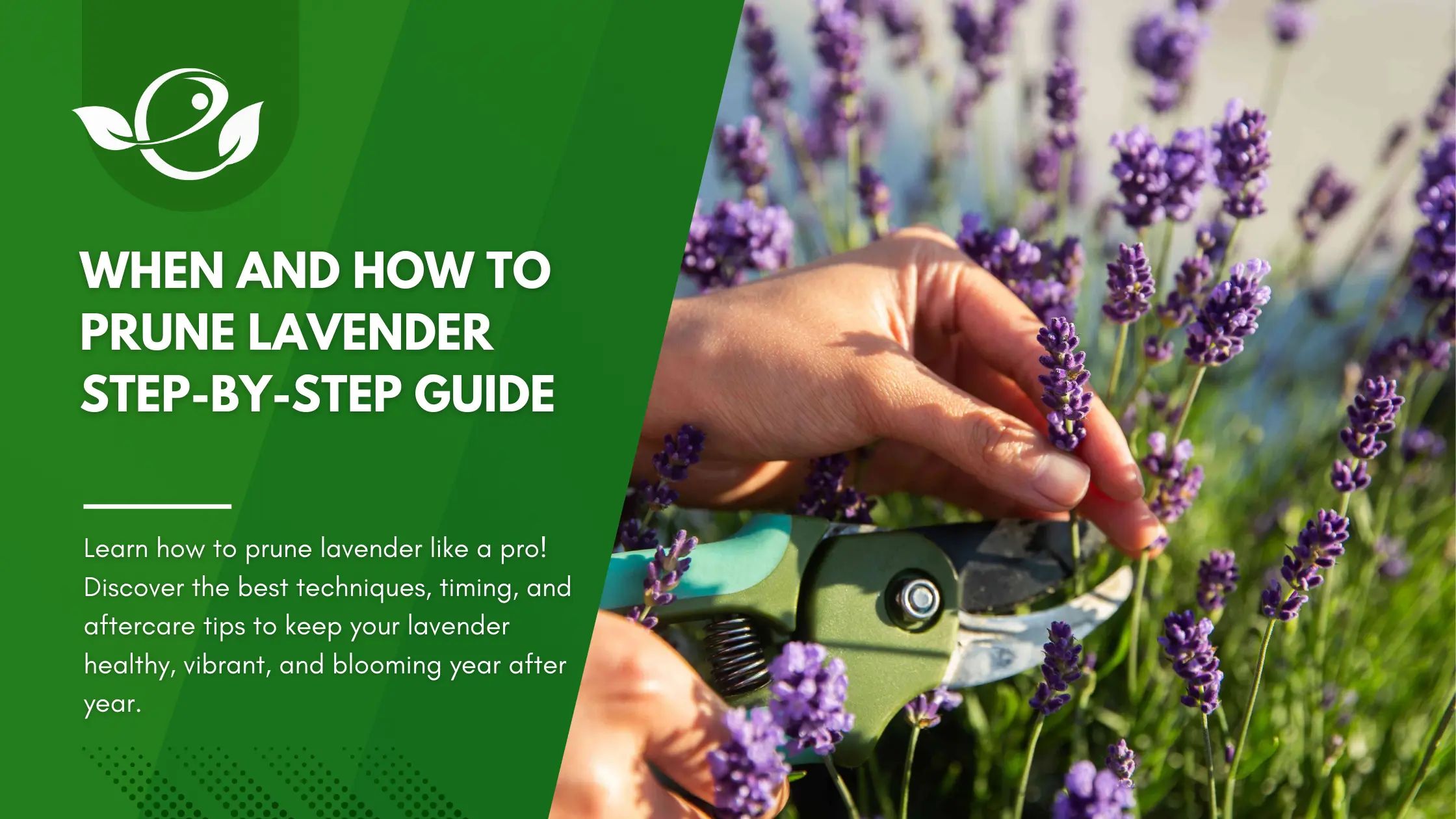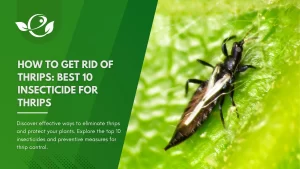Table of Contents
Pruning lavender is a vital gardening task that keeps your plants healthy, beautiful, and bursting with blooms. Whether you’re tending to a fragrant backyard garden in the UK or cultivating a sunny landscape in the U.S., knowing how to prune lavender can make a world of difference. With the right techniques and timing, you can enhance your lavender’s growth, prevent woody stems, and extend its lifespan. This comprehensive guide walks you through everything you need to know, from the importance of pruning to detailed steps, regional considerations, and essential aftercare tips. Let’s ensure your lavender thrives year after year!
Why Pruning Lavender is Essential
Pruning lavender serves more than just an aesthetic purpose. Here are the main reasons why this practice is crucial:
- Encourages Vigorous Growth: Lavender thrives on regular care, and pruning is one of the best ways to stimulate new, healthy growth. By removing spent flower stems and excessive foliage, the plant can redirect its energy into developing fresh stems and leaves. This leads to a fuller, bushier plant that produces more blooms.
- Prevents Woody Growth: As lavender ages, its stems naturally become woody at the base. Woody growth not only reduces the plant’s visual appeal but also makes it less capable of producing vibrant flowers. Pruning helps slow this process by encouraging softer, green growth above the woody base. If neglected, the plant may become too woody, with fewer green shoots and a reduced ability to regenerate.
- Promotes Better Flowering: A well-pruned lavender plant typically yields more flowers. By cutting back spent blooms and thinning out the plant, you improve sunlight penetration and air circulation, which are critical factors for bud formation. Pruning also helps the plant focus its resources on producing robust, aromatic flowers rather than sustaining excessive foliage.
- Extends Plant Longevity: Lavender plants that are pruned regularly tend to live longer. Pruning prevents the plant from becoming overgrown, which can lead to structural weakness and increased susceptibility to diseases and pests. With annual pruning, you ensure the plant remains balanced and healthy, giving it a longer and more productive life.
- Enhances Garden Aesthetics: Lavender’s iconic shape—a compact, rounded mound—is best maintained through pruning. Without it, the plant can grow leggy, uneven, and unsightly. Regular trimming ensures your lavender complements the rest of your garden, acting as a neat and attractive feature.
- Improves Airflow and Reduces Disease Risk: Dense, overgrown lavender can trap moisture and create conditions conducive to fungal diseases. Pruning opens up the plant, allowing better airflow and reducing the risk of issues like root rot or powdery mildew. This is especially important in humid climates or during wet seasons.
- Encourages Safe Harvesting: For those who grow lavender for its essential oils, dried flowers, or culinary uses, pruning serves as an excellent harvesting opportunity. By cutting the stems at the right time and height, you can collect a substantial yield of flowers while simultaneously shaping the plant for future growth.
Failing to prune lavender can lead to leggy, unkempt plants that produce fewer flowers over time. By committing to annual pruning, you can enjoy vibrant lavender for many seasons.
When to Prune Lavender
Understanding the best time to prune lavender is key to ensuring its health, vigor, and ability to produce abundant flowers. Pruning times can vary depending on the type of lavender, your region’s climate, and the plant’s growth stage. Here’s an in-depth look at when to prune lavender for optimal results:
Pruning Seasons
- Early Spring Pruning:
- In early spring, before new growth begins in earnest, perform a light cleanup of your lavender plant. Remove any dead, damaged, or diseased stems left over from winter.
- This is also a good time to cut back lightly, stimulating fresh growth as the growing season begins.
- Early spring pruning is especially beneficial in regions with late frosts, as it helps the plant recover from winter stress and prepares it for the warm months ahead.
- Late Summer to Early Fall Pruning:
- This is the primary pruning season for most lavender varieties. After the plant finishes flowering, typically in late summer, perform a more thorough pruning.
- Cut back the green growth by about one-third to two-thirds, shaping the plant into a neat mound while avoiding the woody base.
- This pruning stage helps the plant focus on storing energy for the upcoming winter while encouraging a compact, balanced structure.
- Midseason Maintenance:
- In some cases, particularly with French and Spanish lavender, you might find it useful to perform a light trim after the first flush of blooms. This encourages a second bloom cycle and keeps the plant tidy.
Timing Based on Regional Climate
The best time to prune lavender also depends on where you’re gardening. Here’s how to adapt your pruning schedule based on your location:
- In the United Kingdom:
- Lavender in the UK typically thrives in the mild, temperate climate, where late summer pruning is ideal. This ensures the plant has enough time to recover and harden off before the cooler months set in.
- Prune in August or early September, but avoid pruning too late in the fall, as this could leave the plant vulnerable to frost damage.
- In the United States:
- Pruning schedules in the U.S. depend on the USDA hardiness zone:
- Zones 5-6 (Cooler Regions): Prune in late summer, soon after the last bloom cycle, to allow recovery before frost.
- Zones 7-9 (Warmer Regions): Pruning can be extended into early fall, as mild winters reduce the risk of frost damage.
- For areas prone to unpredictable weather, adjust pruning to when the plant is no longer actively blooming but still has warm weeks ahead.
- Pruning schedules in the U.S. depend on the USDA hardiness zone:
Important Considerations
- Avoid Winter Pruning:
- Pruning lavender during winter dormancy is a common mistake. Exposed cuts may not heal properly, leaving the plant susceptible to frost damage, rot, or disease.
- Instead, focus on spring or late-summer pruning for healthier results.
- Take Lavender Variety Into Account:
- English lavender (Lavandula angustifolia) tends to be hardier and more forgiving, making it suitable for substantial pruning after flowering.
- French and Spanish varieties (Lavandula dentata and Lavandula stoechas) are less cold-tolerant and benefit from lighter pruning to reduce stress.
- Monitor Blooming Cycles:
- Lavender blooms can vary slightly based on environmental factors, so adapt your pruning schedule to the specific flowering period in your garden. As a rule of thumb, prune after the main flowering phase for best results.
By following these timing guidelines and considering the specific needs of your region and lavender variety, you can maximize the plant’s longevity, health, and flowering potential. Properly timed pruning is an investment in your garden’s beauty and productivity for seasons to come.
How to Prune Lavender: Step-by-Step Guide
Pruning lavender is both an art and a science. While it’s essential to maintain the plant’s health and aesthetics, improper techniques can harm its growth and longevity. Below, we provide a detailed, step-by-step guide to ensure you prune lavender effectively, yielding a healthy, vibrant plant.
1. Gather Your Tools
The right tools make the pruning process efficient and safe for the plant. Ensure you have the following:
- Sharp Pruning Shears: Dull blades can crush the stems instead of cutting cleanly, leading to damage or disease.
- Gloves: Lavender’s oils can be irritating to sensitive skin. Gloves protect your hands and provide a better grip.
- Tarp or Bucket: Use these to collect trimmings and keep your workspace clean.
- Disinfectant: Cleaning your shears with rubbing alcohol or a bleach solution between cuts reduces the risk of spreading disease.
2. Inspect the Plant
Before cutting, take a few moments to assess the lavender plant:
- Identify Dead or Damaged Growth: Look for discolored, brittle, or split stems. These should be removed first to encourage new, healthy growth.
- Locate the Woody Base: Lavender does not regenerate from its woody stems, so it’s crucial to prune only the green, flexible growth.
- Check for Pests or Diseases: Inspect for signs of infestations like aphids or fungal infections, such as powdery mildew. Address these issues before or during pruning to prevent spreading.
3. Begin with Deadheading
Deadheading is the process of removing spent flowers to encourage fresh blooms:
- Use your shears to trim off faded flower stems at their base, just above the first set of leaves.
- For younger plants, deadheading can sometimes stimulate a second flush of blooms in the same growing season.
- Regular deadheading improves the plant’s appearance and allows energy to be redirected toward new growth.
4. Trim Green Growth
Once the dead flowers are removed, move on to shaping the plant:
- Cut Back by One-Third to Two-Thirds: Using sharp shears, trim the soft, green growth while avoiding the woody base. A good rule of thumb is to leave approximately 1-2 inches (2-5 cm) of green above the woody portion.
- Focus on Symmetry: Shape the lavender into a rounded mound. This form not only looks attractive but also prevents uneven growth and promotes airflow.
- Avoid Cutting Too Deep: If you accidentally cut into the woody base, the plant may struggle to recover and could fail to produce new shoots.
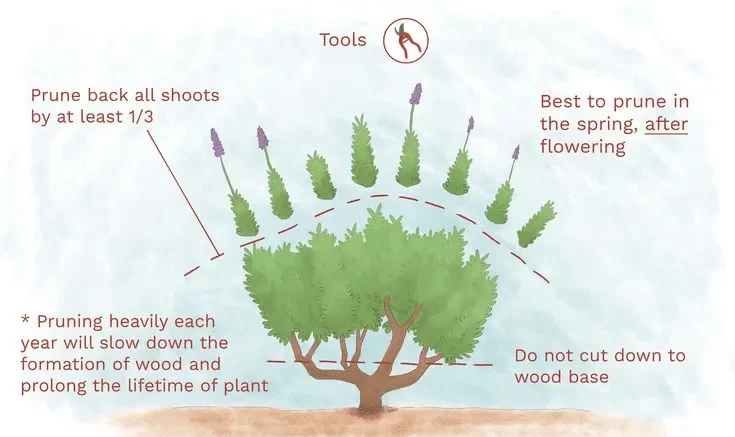
5. Shape the Plant
Lavender’s iconic compact and rounded shape doesn’t happen by chance. Pruning with the goal of symmetry and balance ensures a visually pleasing and structurally sound plant:
- Start at the top of the plant and work your way down, keeping cuts even and smooth.
- For larger plants, step back periodically to assess the overall shape. Correct any irregularities as you go.
- Maintain an open center by removing any overcrowded stems. This promotes better sunlight penetration and airflow.
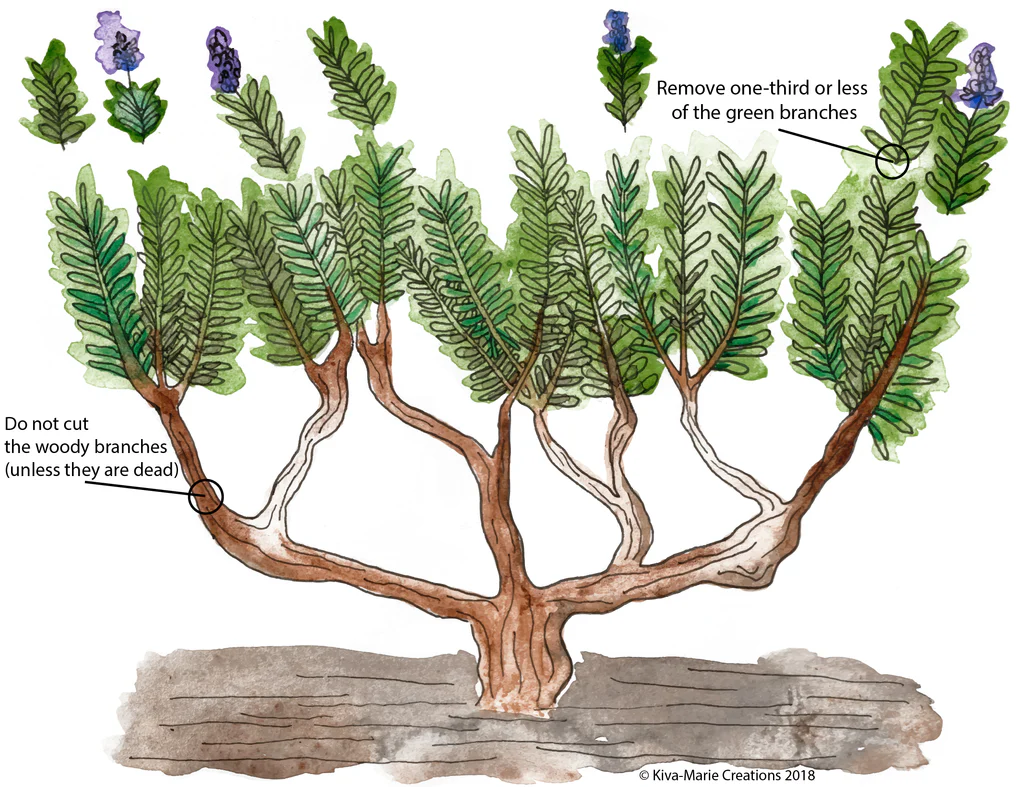
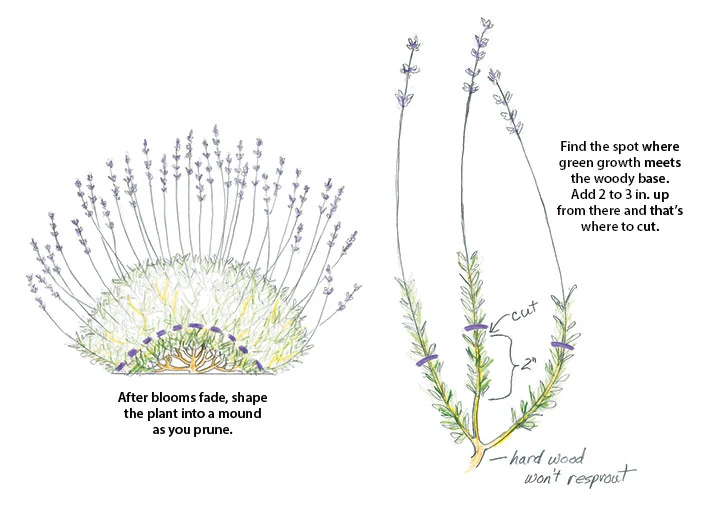
6. Perform a Final Clean-Up
After pruning, tidy up both the plant and its surroundings:
- Remove Loose Debris: Clear away fallen stems, leaves, or flowers around the base of the plant to prevent pests and diseases.
- Dispose of Clippings: Compost healthy trimmings or use them in sachets for their fragrance. Discard any diseased or pest-infested material to avoid contamination.
- Inspect the Plant: Give the lavender a final check to ensure all dead, damaged, or diseased growth has been removed.
7. Tips for Season-Specific Pruning
Timing plays a crucial role in how you prune lavender. Adjust your technique based on the season:
- Spring Pruning:
- Remove any winter-damaged stems and shape the plant lightly to stimulate fresh growth.
- Focus on preparing the lavender for its blooming season.
- Late Summer Pruning:
- After the main flowering period, prune heavily to shape the plant for winter and encourage compact growth.
- Avoid cutting into woody stems during this time to reduce stress on the plant.
Pruning Lavender by Type
Different lavender varieties require slightly different pruning techniques:
1. English Lavender (Lavandula angustifolia):
- This hardy variety is well-suited to most climates and thrives with regular pruning.
- Perform a substantial prune in late summer, cutting back about two-thirds of its green growth.
- English lavender can also handle light spring trimming to remove winter-damaged stems and encourage new shoots.
2. French Lavender (Lavandula dentata):
- French lavender is more delicate and prefers a lighter touch during pruning.
- After its flowering period, remove spent blooms and lightly shape the plant, leaving plenty of green growth to recover.
- Avoid heavy pruning, especially in cooler climates, as this can stress the plant.
3. Spanish Lavender (Lavandula stoechas):
- Known for its distinctive “rabbit ear” blooms, Spanish lavender requires minimal pruning.
- Remove faded flower heads and lightly trim back stems to maintain shape and size.
- This variety is less hardy, so ensure pruning is timed to avoid frost risks.
4. Lavandin (Lavandula x intermedia):
- A hybrid variety prized for its high oil content, lavandin benefits from moderate pruning.
- Follow the one-third rule and avoid cutting into the woody base.
- Prune after its late summer bloom to prepare it for the next growing season.
5. Container-Grown Lavender:
- Lavender grown in pots requires more frequent pruning to maintain its size and prevent overcrowding.
- Trim lightly throughout the growing season and perform a more thorough prune after flowering.
- Ensure adequate watering and fertilization to support recovery.
Regional Considerations for America and the UK
Pruning practices can vary based on climate and growing conditions. Here’s how to adjust your approach based on your location:
America
- Lavender thrives in USDA zones 5-9, with pruning schedules differing by region.
- In cooler regions (zones 5-6), prune in late summer to allow plants to recover before the first frost.
- In warmer regions (zones 7-9), pruning can be done slightly later, as plants have a longer growing season.
- Coastal areas with high humidity may require additional pruning to improve airflow and prevent fungal diseases.
United Kingdom
- The UK’s mild, temperate climate is ideal for lavender. Prune in late summer or early autumn to ensure the plant has time to recover before winter.
- In areas with heavy rainfall, focus on thinning the plant to improve air circulation and reduce moisture retention.
- Consider planting hardier varieties, such as English lavender, to withstand cooler temperatures.
Common Mistakes to Avoid When Pruning Lavender
To ensure healthy, productive plants, steer clear of these common errors:
- Cutting Into Woody Stems: Lavender’s woody base does not regenerate. Always leave a cushion of green growth above this area to prevent irreparable damage.
- Over-Pruning: Removing too much foliage can shock the plant and inhibit growth. Follow the one-third to two-thirds rule to strike the right balance.
- Under-Pruning: Neglecting to prune leads to leggy, untidy plants with fewer blooms. Regular maintenance keeps the plant compact and productive.
- Pruning at the Wrong Time: Avoid pruning in late fall or winter, as frost can damage freshly cut stems. Stick to late summer and early spring for best results.
- Using Dull Tools: Blunt shears can crush stems, increasing the risk of disease. Keep your pruning tools sharp and clean.
Aftercare for Pruned Lavender
Pruning lavender doesn’t end with the snip of the shears; the care you provide afterward is equally important for the plant’s recovery and future health. Proper aftercare ensures your lavender remains resilient and continues to thrive. Here are detailed steps to follow:
- Water Sparingly: Lavender is drought-tolerant, and overwatering after pruning can harm the plant. Water lightly immediately after pruning to help it recover, especially in dry climates. Ensure the soil drains well to prevent root rot.
- Mulching for Protection: Apply a thin layer of mulch around the base of the plant to regulate soil temperature and retain moisture. Organic materials like bark chips or gravel work well, but avoid piling mulch directly against the woody stems to prevent rot.
- Avoid Fertilizing Immediately: Lavender thrives in nutrient-poor soils. Adding fertilizer right after pruning can overstimulate growth, leading to a leggy and less productive plant. If necessary, use a light, balanced fertilizer in early spring rather than after pruning.
- Pest and Disease Monitoring: Fresh cuts can attract pests or become entry points for diseases. Inspect the plant regularly for aphids, spider mites, or fungal issues. Neem oil or insecticidal soap can address minor infestations effectively.
- Support Regrowth with Sunlight: Ensure your lavender receives plenty of sunlight post-pruning. At least 6-8 hours of direct sunlight daily helps stimulate healthy regrowth and promotes flowering.
- Protect from Harsh Weather: In colder regions, pruned lavender may need extra protection during winter. Cover the plant with horticultural fleece or a breathable fabric to shield it from frost and freezing temperatures. Container-grown lavender can be moved indoors or to a sheltered location.
- Clear Debris: Remove all pruning debris from around the plant to prevent pests and diseases from taking hold. This cleanup step is particularly important in humid climates where decaying plant material can harbor fungi.
- Monitor Growth: Keep an eye on your lavender’s regrowth over the next few weeks. Healthy plants will quickly develop new shoots. If growth appears stunted, reassess watering practices or inspect for pests and soil issues.
FAQs About Pruning Lavender
When should lavender be cut back?
Lavender should be cut back in late summer or early fall after flowering, with light pruning in early spring to remove winter damage.
Where do you cut lavender for pruning?
Cut lavender above the woody base, leaving at least a few inches of green growth to promote regeneration.
Should I deadhead lavender after flowering?
Yes, deadheading spent blooms encourage more flowers and keep the plant tidy.
What happens if lavender is not cut back?
Unpruned lavender becomes leggy, woody, and less productive, with fewer blooms and a shorter lifespan.
What is the lifespan of a lavender plant?
Lavender plants typically live 10–15 years with proper care and pruning.
Is lavender safe for dogs?
Lavender is considered toxic to dogs by the ASPCA. If ingested, it can cause nausea, vomiting, and inappetence due to a compound called linalool. Always keep lavender out of your pets’ reach to avoid accidental ingestion.
Conclusion
Pruning lavender is more than a maintenance task—it’s an investment in the health and beauty of your garden. By understanding when and how to prune lavender effectively, you can enjoy lush, fragrant blooms and a longer plant lifespan. Avoid common mistakes, tailor your approach to your region and lavender type, and follow the aftercare tips for the best results. With regular pruning, your lavender will remain a show-stopping feature of your garden, ready to delight season after season. Take the first step today and let your lavender thrive!
Have questions or tips to share? Leave a comment below and join the conversation!
